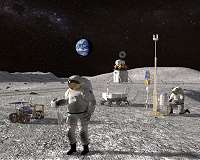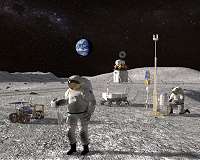NASA has awarded Southwest Research Institute $3 million to create a lunar version of its Laser Absorption Spectrometer for Volatiles and Evolved Gas (LASVEGAS) instrument. This spectrometer can measure the volatile chemicals within planetary atmospheres and surfaces – critical information for space science and exploration.
It is exceptionally compact, low mass, low volume and low electricity – all important features for spaceflight,” said SwRI’s Dr. Scot Rafkin, principal investigator of this tool.
“It can be set up on the tiniest of rovers or landers in addition to transported in a single hand by an astronaut sauntering across the lunar surface in search of water ice, methane and other useful resources.”
The tool measures gases to understand their makeup. It can heat a sample of a surface like the icy surface of Jupiter’s moon Europa or by lunar soil to find out the composition of gases that are released.
NASA’s Maturation of Instruments for Solar System Exploration (MatISSE) program provided $3M in 2019 to create the LASVEGAS tool for application to both Europa and similar icy worlds. In 2020, SwRI obtained an extra $3 million from the bureau’s Development and Advancement of Lunar Instrumentation (DALI) program to adapt the design to function on the Moon’s surface.
“Spectrometry is just one of the key analytical tools used in space exploration,” Rafkin said.
The gas flows into a small chamber where laser light of different wavelengths is bounced back and forth between mirrors on every end. Since the light passes through the gasoline in the sample, the distinct molecular species in the gas absorb the light differently depending on the wavelength.
The laser light is directed onto a detector that measures its own intensity to ascertain the abundance of these chemicals. Each molecular species in the gasoline has a different”fingerprint” of absorption, showing its overall abundance.
“The tool is yet to be selected for flight on a mission, but the work financed under the MatISSE and DALI applications will allow the instrument to be credibly proposed for a variety of future opportunities, especially those related to the return of people to the surface of the Moon,” Rafkin said.
The LASVEGAS development team also includes Ball Aerospace, Southwest Sciences Inc. and Princeton University.
– Advertisement –


